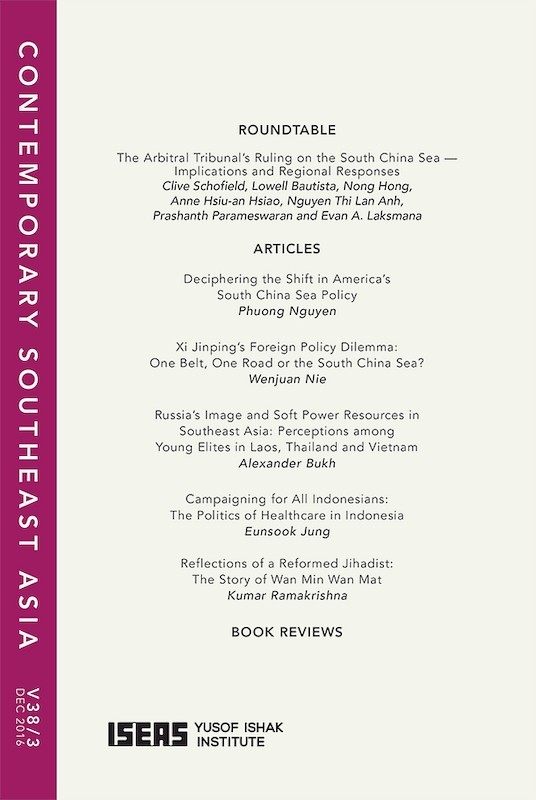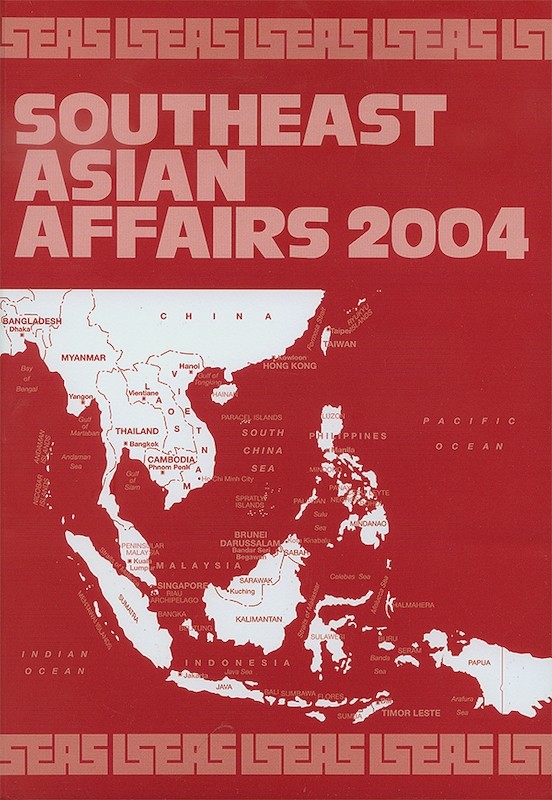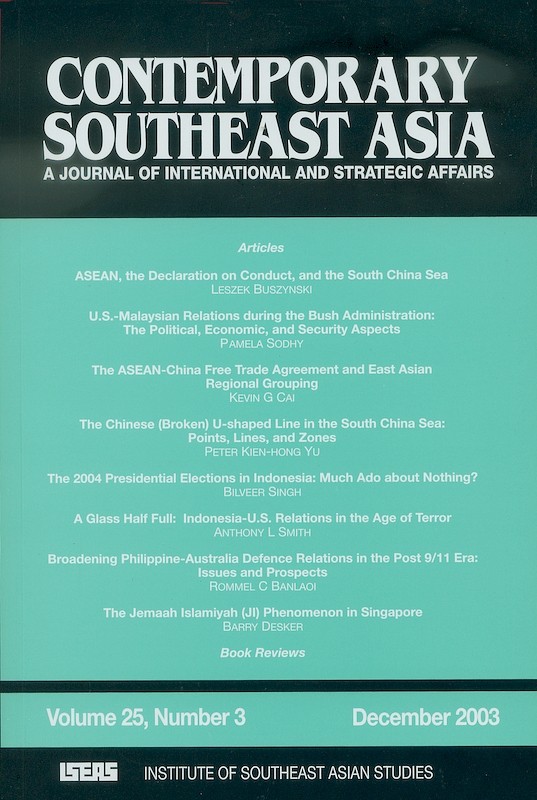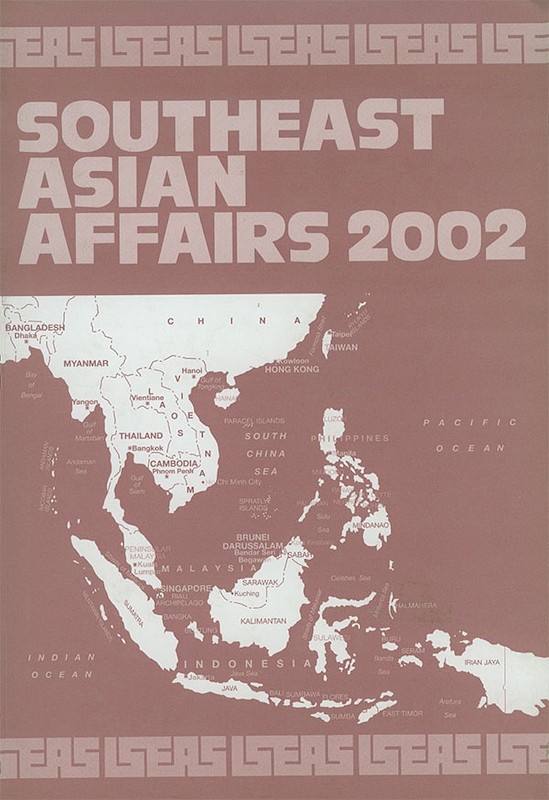Contemporary Southeast Asia Vol. 41/1 (April 2019). Special Issue: Militant Islam in Southeast Asia: New Insights into Jihad in Indonesia, Malaysia and the Philippines
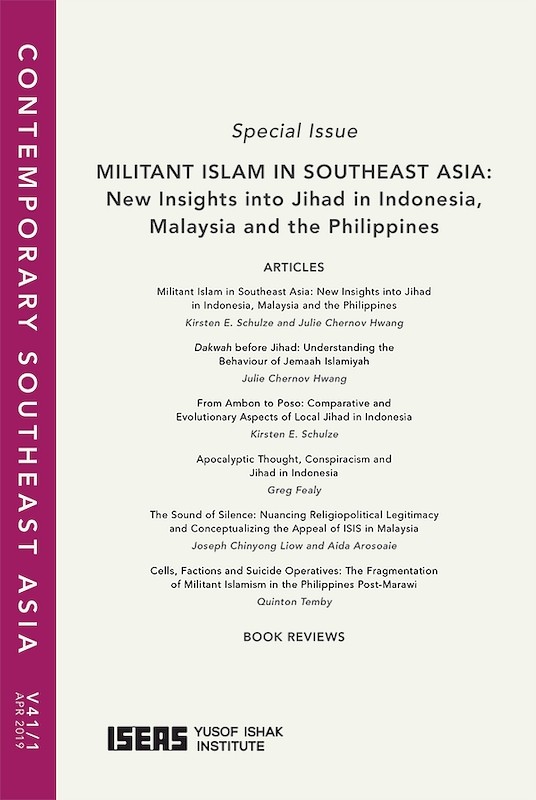
Ian Storey, editor
Date of publication:
April 2019
Publisher:
ISEAS – Yusof Ishak Institute
Number of pages:
152
Code:
CS41/1
About the publication
- Attained impact factor of 0.906 in Social Sciences Citation Index 2017
- Ranked 18th by Google Scholar Metrics 2018 in the Asian Studies and History category
Contents
-
Contemporary Southeast Asia Vol. 41/1 (April 2019). Special Issue: Militant Islam in Southeast Asia: New Insights into Jihad in Indonesia, Malaysia and the Philippines
[Whole Publication, ISSN: 1793284X] -
Preliminary pages
- ARTICLES
-
1. Militant Islam in Southeast Asia: New Insights into Jihad in Indonesia, Malaysia and the Philippines, by Kirsten E Schulze, Julie Chernov Hwang, authors
-
2. Dakwah before Jihad: Understanding the Behaviour of Jemaah Islamiyah, by Julie Chernov Hwang, author see abstractWhat prompted Jemaah Islamiyah (JI) to turn away from terror tactics? This article argues JI did not disengage from violence per se because it did not demobilize and disarm. Instead, it is more appropriate to view JI as having postponed amaliyat (actions) until such time as it has built up sufficient support among the population. This occurred in response to three factors: the realization of the costs exacted on the network by the 2002 Bali bombing; the splintering off of the group’s pro-bombing wing; and the series of mass arrests following the disruption of its project to build a secure base in Poso, Central Sulawesi. Taken together, these events reinforced the understanding that dakwah (Islamic propagation) had to precede jihad, a view that was already present within parts of the JI network prior to certain members’ decision to undertake terrorist attacks. This article explores how JI members who were involved in terror attacks revised their previously held views in light of these experiences.
-
3. From Ambon to Poso: Comparative and Evolutionary Aspects of Local Jihad in Indonesia, by Kirsten E Schulze, author see abstractThis article looks at the first two local jihads in Indonesia after the fall of President Suharto: the 1999–2005 Ambon jihad and the 2000–7 Poso jihad. Both jihads were launched by Javanese mujahidin in response to the eruption of Christian–Muslim communal violence. The Ambon jihad was characterized by disagreement, infighting and lack of strategic direction, while the Poso jihad was comparatively better led and linked to the broader goals of establishing an Islamic state in Indonesia. This article explores the differences between the two jihads and asks to what extent the better organization of the Poso jihad was the result of lessons learnt from the “mistakes” of the Ambon jihad. The article advances two arguments. First, the Ambon jihad was undermined by the lengthy debate within Jemaah Islamiyah (JI) on how to respond to the Ambon conflict as well as by the shifting dynamics between JI, Mujahidin KOMPAK and Laskar Jihad. Second, that the Poso jihad was more organized than the Ambon one because JI’s leadership had a more comprehensive approach to the Poso jihad; because JI and Mujahidin KOMPAK had learnt from the mistakes of the Ambon jihad in the areas of leadership, training and using local jihads to achieve national aims; and because the intra- and inter-mujahidin dynamics and with it the “state of jihad” had evolved between February 1999 and September 2000.
-
4. Apocalyptic Thought, Conspiracism and Jihad in Indonesia, by Greg Fealy, author see abstractThe impact of apocalyptic and conspiracist discourses on Indonesian jihadi thinking and behaviour has been little studied, but evidence in recent years is mounting that it has been significant. Many Indonesians who joined Islamic State forces in Syria and Iraq from 2013 were driven in part by a belief that the final cataclysmic battle between Islam and its foes would occur there imminently, and the families responsible for the 2018 Surabaya suicide bombing which killed more than two dozen people were convinced that the world would soon end. This article examines Indonesia’s contemporary apocalyptic literature, with an emphasis on the two main genres: populist and jihadist. It argues that the populist forms, though sensational, highly conspiratorial and commercially motivated, are more insidious than commonly assumed, and can have a “priming effect” upon radicalizing readers by deepening their sense of crisis and grievance, thus inclining them to extreme views and actions. Jihadi apocalypticism has a stronger scholarly basis, but is subject to serious debate and some scepticism within Islamist circles. For some jihadis, such discourses bring a compelling urgency that triggers violence, but for others, apocalypticism is viewed more warily due to the risk that it impairs judgement and leads to erroneous strategies.
-
5. The Sound of Silence: Nuancing Religiopolitical Legitimacy and Conceptualizing the Appeal of ISIS in Malaysia, by Joseph Chinyong Liow, Aida Arosoaie, authors see abstractWhile Malaysia has often been portrayed in the popular media as a progressive and pluralist country, some scholars have argued that an upsurge in religious conservatism — manifesting itself in exclusivist Islamist narratives — has created the conditions from which extremist ideas associated with ISIS draw support and sympathy. Yet even as legitimate concern for the appeal of ISIS and the return of foreign fighters grows, the very existence of these conservative and exclusivist religiopolitical narratives articulated by Malaysian Islamists operating in and referenced to a distinctly Malaysian context in fact limits the appeal of ISIS in Malaysia. By focusing specifically on the nexus between religion and ethnicity in Malaysia, and the historical development of a modern yet traditionally rooted expression of Malay-Islamic identity in contradistinction to “Westernization”, this article reveals the underpinnings of Malay Muslim religiopolitical legitimacy and contrasts them to the narratives of ISIS, outlining that ISIS’s failure to adequately contextualize its narratives has significantly blunted the terrorist organization’s appeal.
-
6. Cells, Factions and Suicide Operatives: The Fragmentation of Militant Islamism in the Philippines Post-Marawi, by Quinton Temby, author see abstractThe siege of Marawi City in 2017 by militants flying the black flag of the Islamic State in Iraq and Syria (ISIS) was one of the most significant events in the development of militant Islamism in Southeast Asia. The devastation of the attack, however, was followed by a major breakthrough in the peace process in the Southern Philippines with the formation in early 2019 of the Bangsamoro Autonomous Region in Muslim Mindanao (BARMM). The consequences of these two major events represent a critical juncture in the conflict in Mindanao in which the pattern of militant Islamism is highly fluid. Surveying the situation in Mindanao post-Marawi siege, this article argues that, in parallel to the decline of ISIS in the Middle East, the conflict in Mindanao is undergoing a transitional phase in which the dominant pattern of militant Islamism is shifting from one of insurgency to clandestine terrorism, characterized by a protean network of small but more ruthless groups. This development is marked by the emergence for the first time ever of suicide bombings in the Philippines. If suicide bombing becomes normalized in the Philippines as the most desperate tactic of a decentralized terrorist network, it will present a formidable new challenge to both the Philippine state and the nascent autonomous government in Muslim Mindanao.
- BOOK REVIEWS
-
BOOK REVIEW: Unmarked Graves: Death and Survival in the Anti-Communist Violence in East Java, Indonesia, by Vannessa Hearman, by Annie Pohlman, author
-
BOOK REVIEW: Asian Waters: The Struggle Over the South China Sea and the Strategy of Chinese Expansion, by Humphrey Hawksley, by Hoang Thi Ha, author
-
BOOK REVIEW: The Business of Transition: Law Reform, Development and Economics in Myanmar, edited by Melissa Crouch, by Andrew Harding, author
-
BOOK REVIEW: Last Days of the Mighty Mekong, by Brian Eyler, by Pichamon Yeophantong, author

